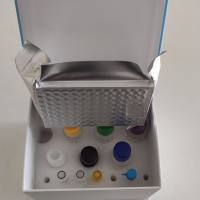Targeted Amplification of Mutant Strand (TAMS) technology for site directed mutagenesis
互联网
1018
| Overview | |
|
Targeted Amplification of Mutant Strand (TAMS) technology allows multiple-site mutagenesis in a simple, half-day protocol. It’s the only method that can mutate first strand cDNA directly, and perform multiple-site mutagenesis at high efficiency in a single round. TAMS technology takes advantage of the fact that primers with 3’ mismatches usually cannot amplify the target sequence. Therefore, if two anchor mutations are incorporated into the mutant DNA strand outside the desired mutations, they can be preferentially amplified by primers with 3’ sequence matching the mutant strand but not the wild-type strand. Since the desired mutations are in the mutant strand, the final PCR product will also contain the desired mutations. |
|
| Material | |
|
5x mutation buffer: 250mM Tris-HCl (pH 7.6), 50mM MgCl2, 50mM DTT, 5mM ATP, and 1mM dNTP. T4 DNA polymerase, ligase and polynucleotide kinase, RNase H Control b-actin anchor mutagenic oligos: CGCTCGTCGTCGATCACGGCTC, AAAACCTACTGTGCGCA Control b-actin mutagenic oligos: TGTACGTTGATATCCAG, TCCTGCGTCTAGACCTG, GCGCGGCTACAGCTCGAGCTGCCTGACG, GCCGACAGGCTGCAGAA, AGCGCAAGTAATCCGTG, CTGGGCATGGATCCGTCCTGTGGCA Control b-actin anchor PCR primers: GCGCTCGTCGTCGATCA, TTGTTTTCTGCGCACAG |
|
| Procedure | |
|
1. ssDNA template preparation a) From RNA: Perform reverse transcription with 5mg total RNA and oligo dT primer in 20ul reaction following manufacturer’s protocol. Add 1ul Ribonuclease H and incubate at 37°C for 1 hour. First strand cDNA should be used as template for the b-actin control reactions. b) From Genomic DNA: Perform 30 cycles of asymmetrical PCR with primer for the strand to be used as template at 20x concentration of the non-template strand primer. c) From plasmid: Perform 30 cycles of linear PCR with 100ng of template and 1 primer only. 2. Design of mutagenic oligonucleotides Follow reference [1] for oligo design, generally a 17-19mer with single mutation in the middle will be sufficient. Make sure the mutagenic oligos are complementary to the ssDNA template. The anchor mutagenic oligo should provide three 3’ mismatched nucleotides for the anchor PCR primers to anneal to. 3. Mutagenesis protocol a) Prepare the control and sample reactions as follows: 4ul of 5x mutation buffer 2pmol each of anchor mutagenic primers 10pmol each of desired mutagenic primers water to final volume of 17ul b) Add 1ul of T4 polynucleotide kinase (5U) and incubate at 37°C for 1 hour. c) Add 2ul of the single stranded DNA template. Place tubes in a beaker containing 1L of 75°C water and allow slow cooling to room temperature. d) Add 1ul of T4 DNA polymerase (5U) and 1ul of T4 DNA ligase (3U), and incubate at 37°C for 1 hour. e) Amplify 1ul of either the control reaction or sample reaction by any thermal stable polymerase with the respective anchor PCR primers. Set PCR conditions to 1 cycle at 94°C for 1 min; 25 cycles at 94°C for 30 sec, 55°C for 30 sec, 72°C for 1 min/kb; and 1 cycle at 72°C for 5 min. f) Run 10ul of the reaction on 1% agarose gel, if bands of expected size can be seen (1kb for b-actin control reaction), then mutagenesis is successful. The PCR product can be used in subsequent applications. |









